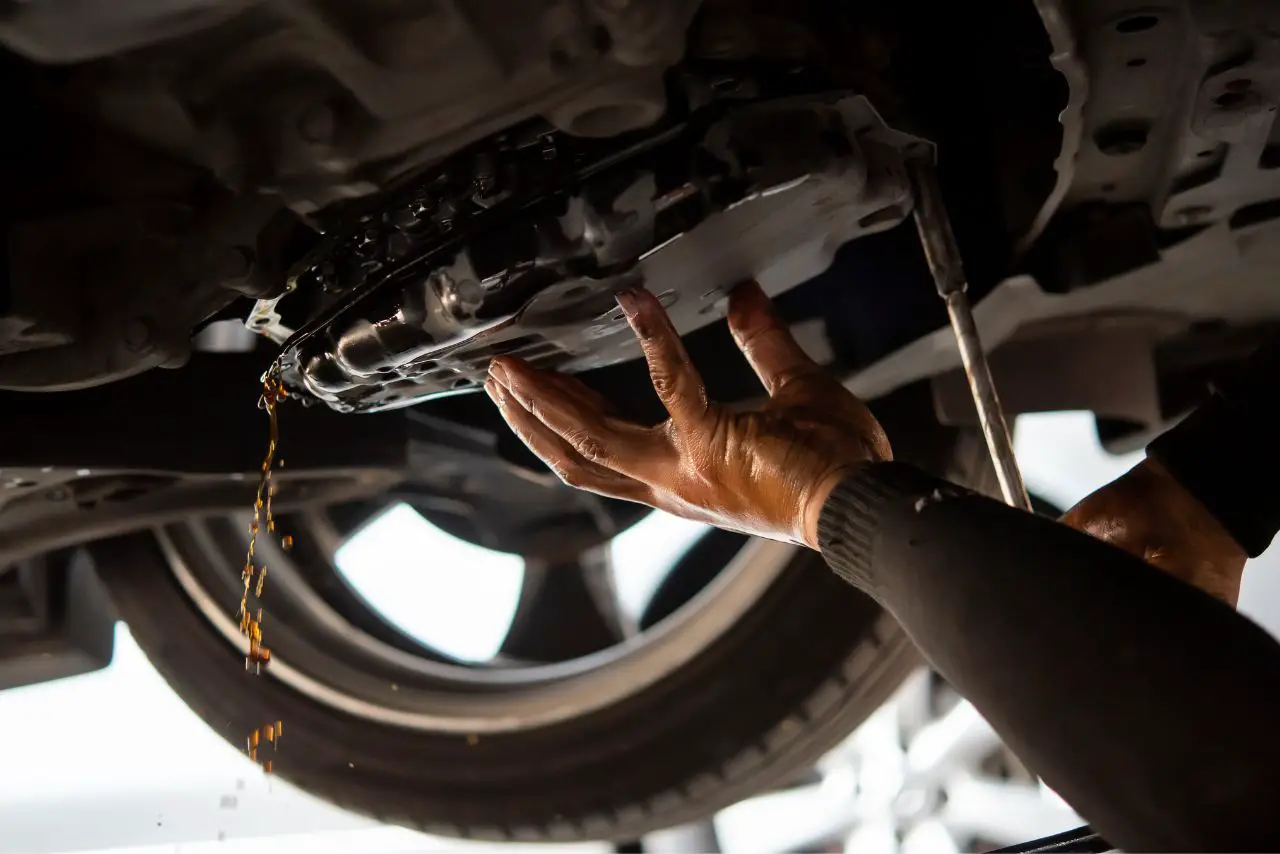If you’re wondering Why Does Radiator Fluid Have Sediment In It? you’re not alone.
Sediment in radiator fluid is a common problem that can lead to serious engine damage if left unaddressed.
In this article, we’ll explore the reasons behind sediment buildup in radiator fluid, the symptoms to watch out for, and the preventative measures you can take to keep your engine running smoothly.
Table of contents
So, Why Does Radiator Fluid Have Sediment In It?
Radiator fluid, also known as coolant, can have sediment in it due to several reasons:
- Rust and Corrosion: Over time, the metal components in the cooling system can corrode and rust. This can cause small particles of metal to break off and mix with the coolant, leading to sediment buildup.
- Mineral Deposits: Impurities in the water used to mix the coolant can also cause sediment buildup. These impurities can include minerals like calcium and magnesium, which can form sediment when mixed with the coolant.
- Oil Contamination: If oil from the engine leaks into the cooling system, it can mix with the coolant and cause sediment buildup.
- Overheating: If the engine is allowed to overheat, it can cause the coolant to break down and form sediment.
It is important to address sediment buildup in the coolant as it can cause clogs in the cooling system and lead to engine overheating and damage. Flushing the system and replacing the coolant can help prevent sediment buildup.
What is Sediment in Radiator Fluid?
The presence of sediment in radiator fluid can be attributed to various factors such as corrosion and mineral buildup.
Sediment refers to the solid particles that are suspended in the fluid. These particles can be of different types, including rust, dirt, and minerals.
Sediment buildup can cause damage to the radiator by clogging the tubes and creating hotspots that can lead to cracks.
The chemical composition of the sediments can vary depending on the source of contamination.
Rust particles are usually formed when the metal parts of the radiator corrode due to exposure to air and water.
Dirt particles can come from various sources, such as the road or the environment.
Mineral buildup is often caused by the presence of hard water, which contains high levels of calcium and magnesium ions that can bind to the metal surfaces.
It is essential to identify the type of sediment in the radiator fluid to determine the appropriate solution.
Flushing the radiator and adding a rust inhibitor can help prevent corrosion. Using distilled water instead of hard water can prevent mineral buildup.
Regular maintenance and inspection of the radiator can also help prevent sediment buildup and ensure the efficient operation of the cooling system.
Causes Of Radiator Fluid Have Sediment In It:
| Cause | Description |
|---|---|
| Old radiator fluid | Over time, radiator fluid breaks down and loses its effectiveness. This can lead to the formation of sediment, which can clog the radiator and cause overheating. |
| Corrosion | Corrosion can occur in the radiator and other parts of the cooling system. This can also lead to the formation of sediment. |
| Leaks | If there is a leak in the cooling system, air can get in and mix with the radiator fluid. This can cause the formation of sediment. |
| Improper maintenance | If the cooling system is not properly maintained, sediment can build up. This can be caused by not changing the radiator fluid regularly, not flushing the cooling system, or using the wrong type of radiator fluid. |
Rust and Corrosion:
One possible reason for sediment in radiator fluid could be due to rust and corrosion causing tiny particles to accumulate over time.
This happens when water mixes with the metal parts of the engine, causing rust to form.
Rust particles then mix with the radiator fluid, causing sediment to form in the system. It’s important to note that rust and corrosion can also lead to leaks and other damage over time.
How To Prevent?
To prevent rust and corrosion from forming in your engine, there are a few things you can do.
First, you can add chemical additives to your radiator fluid. These additives can help prevent rust from forming by creating a protective coating on the metal surfaces in the engine.
Additionally, you should make sure to flush your radiator system regularly to remove any sediment that may have accumulated over time.
Overall, it’s important to take good care of your radiator system to prevent sediment from forming and potentially damaging your engine.
By using rust prevention methods and regularly flushing your system, you can keep your engine running smoothly and avoid costly repairs down the line.
Debris and Dirt:
When you drive your vehicle, debris and dirt can make their way into the engine through a variety of sources.
These can include dirt and dust from the road, bits of rubber from tires, and even debris from the environment around you.
When this debris and dirt accumulate in the engine, they can cause problems for the radiator fluid, reducing its effectiveness and potentially leading to overheating.
It’s important to understand how these sources of debris and dirt can affect your vehicle’s engine, so you can take steps to keep it clean and running smoothly.
Sources of Debris and Dirt in the Engine:
You’ll often find debris and dirt in your engine, which can eventually find their way into your radiator fluid, causing sediment buildup.
Oil Contamination:
One of the main sources of this debris and dirt is oil contamination. As your engine runs, oil circulates through it, lubricating its moving parts.
Over time, this oil can become contaminated with tiny particles of metal, dirt, and other materials, which can then be carried around the engine and eventually make their way into the radiator.
Engine Wear:
Another source of debris and dirt in your engine is engine wear. As your engine ages, its various components will begin to wear down, creating tiny metal particles that can mix with the oil and other fluids in the engine.
These particles can then circulate through the engine and end up in your radiator, contributing to sediment buildup.
Regular maintenance, such as oil changes and engine inspections, can help prevent engine wear and keep your radiator fluid free of sediment.
How Debris and Dirt Affect Radiator Fluid?

To keep your engine running smoothly, it’s important to understand how debris and dirt can impact the effectiveness of your radiator.
When debris and dirt accumulate in your radiator fluid, they can cause clogging that can prevent proper coolant circulation. This can lead to overheating, which can cause engine damage, and ultimately, a costly repair bill.
To prevent clogging and ensure optimal cooling system maintenance, it’s essential to flush your radiator fluid regularly.
This will remove any accumulated debris and dirt that can cause clogging and reduce the efficiency of your radiator.
By doing this, you can keep your engine running smoothly and avoid costly repairs down the road.
Remember, keeping your engine cool is essential to ensure optimal performance and longevity, so make sure to prioritize cooling system maintenance.
How to Fix Brown Sludge in Radiator?
Here are some steps that can help to fix brown sludge in a radiator:
- Drain the radiator: Start by draining the radiator of all coolant. This will remove any sludge that has accumulated in the system.
- Flush the system: After draining the radiator, flush the system with water. This will help to remove any remaining sludge and debris from the system.
- Use a radiator flush solution: If flushing with water alone doesn’t work, you can try using a radiator flush solution. Follow the instructions on the bottle carefully and be sure to flush the system thoroughly after using the solution.
- Replace the coolant: Once you have cleaned the system, replace the coolant with fresh coolant. This will help to keep the system running smoothly and prevent sludge from building up in the future.
- Check for other issues: If the brown sludge continues to appear in the radiator, there may be other issues with the system that need to be addressed. Check for leaks, damaged hoses, and other signs of wear and tear that may be contributing to the problem.
How to Flush Gelled Antifreeze?
- Drain the coolant: First, locate the drain plug at the bottom of the radiator and open it. Allow the coolant to drain completely into a container.
- Add a flushing agent: Once the coolant has drained, add a flushing agent to the radiator. Follow the instructions on the product label for the correct amount.
- Fill with water: Fill the radiator with water until it is full. Replace the radiator cap and start the engine. Let it run for 10-15 minutes to circulate the flushing agent.
- Drain the water: After the engine has run for 10-15 minutes, turn it off and open the drain plug to drain the water and flushing agent mixture.
- Refill with antifreeze: Once all the water has drained, refill the radiator with fresh antifreeze. Make sure to follow the manufacturer’s instructions for the correct antifreeze to use and the correct amount.
- Bleed the system: Run the engine with the radiator cap off for a few minutes to allow any air bubbles to escape. Then, top off the radiator with more antifreeze as needed.
- Check for leaks: Finally, check for any leaks and make sure the radiator is full before closing the cap.
White Sludge in Coolant Reservoir:
White sludge in a coolant reservoir can be a sign of a few different problems. One possible cause is a blown head gasket, which can cause coolant to mix with engine oil and create a milky white substance.
Another possible cause is a buildup of mineral deposits, which can occur over time and create a white or gray sludge.
In some cases, the sludge may be caused by a coolant leak, which can allow air to enter the system and create a frothy white substance.
If you notice white sludge in your coolant reservoir, it is important to have your vehicle inspected by a qualified mechanic to determine the cause and address any underlying issues.
Symptoms of Sediment in Radiator Fluid:
According to Federal Motor Vehicle, There are almost 91% peoples who are Experiencing radiator fluid issues, Experiencing sediment in your radiator fluid can indicate potential engine issues and should be addressed promptly.
Sediment can lead to clogs and blockages, causing your engine to overheat and potentially causing serious damage.
When sediment builds up in your radiator, it can also affect the efficiency of your engine, leading to decreased fuel economy and performance.
If you notice sediment in your radiator fluid, it’s important to have your vehicle inspected by a professional mechanic.
They can diagnose the issue and recommend the best course of action.
Depending on the cause and severity of the sediment buildup, it may be necessary to flush your radiator and replace the fluid, or even replace the radiator itself.
Ignoring sediment in your radiator fluid can have serious consequences for your engine and your wallet.
Taking action to address this issue early can ensure that your engine runs smoothly and efficiently, saving you money on repairs and fuel costs in the long run.
So, don’t hesitate to have your vehicle inspected if you suspect sediment buildup in your radiator fluid.
Prevention and Maintenance:
Maintaining your vehicle’s cooling system is vital for preventing costly engine damage and ensuring optimal performance.
Sediment in radiator fluid can cause clogs in the system, leading to overheating and potentially damaging your engine.
To prevent sediment buildup, there are several preventive measures you can take.
- Firstly, make sure to have your cooling system flushed and refilled regularly. This will remove any sediment buildup and replace the old fluid with fresh, clean coolant. It’s recommended to have this done every two to three years, depending on the manufacturer’s recommendations.
- Secondly, use high-quality coolant that is compatible with your vehicle’s make and model. This will help prevent corrosion and sediment buildup in the cooling system. Be sure to follow the manufacturer’s recommendations for the proper coolant to use.
- Thirdly, keep an eye on the temperature gauge and watch for any signs of overheating, such as steam coming from the engine or a burning smell. If you notice any of these signs, it’s important to have your vehicle inspected by a professional as soon as possible.
- Fourthly, check your radiator and hoses for any leaks or cracks. If you notice any, have them repaired or replaced immediately to prevent coolant loss and potential engine damage.
- Lastly, consider using a coolant additive that can help keep your cooling system clean and prevent sediment buildup. These additives can also provide additional protection against corrosion and overheating.
By taking these preventive measures and regularly replacing your radiator fluid, you can help ensure the longevity and optimal performance of your vehicle’s cooling system.
Why Does My Radiator Fluid Look Like Mud?
I can provide some possible reasons why radiator fluid looks like mud:
- Rust: Radiator fluid that looks like mud may indicate rust in the cooling system. Rust can form when air enters the cooling system, causing oxidation and corrosion of the metal components.
- Contaminants: Contaminants like dirt, dust, and debris can also cause the radiator fluid to look like mud. These contaminants may enter the cooling system through leaks or a damaged radiator cap.
- Oil: If the radiator fluid looks like mud and has an oily consistency, it could be due to a blown head gasket. This can cause oil to mix with the coolant and form a muddy texture.
- Overheating: Overheating can cause the radiator fluid to break down and form a muddy texture. This can be caused by a malfunctioning thermostat, a blocked radiator, or a faulty water pump.
If you notice that your radiator fluid looks like mud, it’s important to have it checked by a mechanic to determine the underlying cause and prevent further damage to your vehicle.
Professional Help:
When you notice sediment in your radiator fluid, it may be time to seek professional help.
Mechanics have the expertise to diagnose the issue and recommend the appropriate solution.
They may use specialized tools to flush the radiator and remove any build-up, or replace damaged components if necessary.
Trusting the professionals can help ensure that your vehicle runs smoothly and efficiently.
When to Seek Professional Help?
If you notice sediment in your radiator fluid, it’s best to consult with a professional mechanic to prevent further damage to your engine.
Sediment in the coolant could be a sign of a more significant problem, such as a damaged cylinder head or a blown head gasket.
A professional mechanic will be able to diagnose the issue and provide the appropriate solution, which could range from a simple coolant flush to a more extensive repair.
Before seeking professional help, you may want to try some DIY solutions to see if the problem can be resolved without spending too much money.
Common causes of sediment in radiator fluid include rust, corrosion, and mineral buildup. To address these issues, you can try adding a radiator cleaner or flushing the coolant system.
However, keep in mind that these DIY solutions may not always be effective, and it’s crucial to seek professional help if the sediment persists.
Cost-effective alternatives such as using distilled water instead of tap water and regularly changing the coolant can also help prevent sediment buildup.
How Mechanics Diagnose and Fix Sediment in Radiator Fluid?
To properly diagnose and fix sediment buildup in your car’s coolant system, a skilled mechanic will need to inspect the engine and use specialized tools to identify the root cause of the problem.
Here’s what a mechanic will do to address sediment in your radiator fluid:
- Inspect the radiator, hoses, and water pump for leaks or damage.
- Check the coolant level and condition to ensure it is not contaminated with debris or oil.
- Perform a pressure test to identify any leaks or pressure issues.
- Use a hydrometer to test the coolant’s freezing point and determine if it needs to be flushed and replaced.
- If necessary, drain and flush the coolant system and replace any damaged parts.
- The cost of repair for sediment buildup in your radiator fluid can vary depending on the root cause of the issue. DIY solutions are not recommended, as they can often lead to further damage and costly repairs down the line. It’s best to leave this type of repair to a skilled mechanic to ensure it’s done correctly and efficiently.
Frequently Asked Questions:
What are the different types of radiator fluid sediment?
There are various types of radiator fluid sediment, including rust, scale, and debris. These sediments accumulate over time due to corrosion, chemical reactions, and improper maintenance. They can clog the radiator and reduce cooling performance, leading to engine overheating.
Can sediment in radiator fluid cause engine damage?
Sediment in radiator fluid can cause engine damage by clogging the system and reducing coolant flow, leading to overheating and potential engine failure. Regular radiator maintenance is important to prevent these effects on engine performance.
How often should radiator fluid be flushed to prevent sediment buildup?
To prevent sediment buildup in radiator fluid, consider a professional flush every 30,000 miles. DIY may save money, but lacks the thoroughness of professional equipment. Watch for signs of discoloration or grittiness. Keep your engine healthy and free to roam.
Are there any DIY techniques for removing sediment from radiator fluid?
To remove sediment from radiator fluid, alternative solutions include using a chemical flush or a DIY flush using distilled water and vinegar. Potential risks include damaging the radiator or engine if not done correctly.
Can sediment in radiator fluid affect the efficiency of the car’s heating system?
Sediment in radiator fluid can negatively impact the car’s heating system efficiency. It can cause clogs and prevent proper circulation, leading to overheating. Using high-quality radiator fluid and regularly flushing the system can prolong the radiator’s lifespan and prevent issues.
Conclusion and final thoughts 💭
Congratulations on finishing this article on why radiator fluid can have sediment in it.
As you now know, sediment in radiator fluid can be caused by rust and corrosion, as well as debris and dirt that accumulate over time.
These sediments can cause blockages in the cooling system, leading to engine overheating and potential damage.
To prevent sediment buildup, it is important to regularly maintain and flush your radiator fluid.
This means checking the fluid levels and color, and replacing it according to your manufacturer’s recommendations.
Additionally, using high-quality coolant and keeping your engine clean can also help prevent sediment buildup.
If you notice any of the symptoms of sediment buildup, such as decreased engine performance, overheating, or unusual noises, it is important to seek professional help immediately.
A trained mechanic can diagnose and fix any issues with your cooling system, ensuring that your vehicle runs smoothly and safely.
By understanding the causes and symptoms of sediment buildup in radiator fluid, as well as how to prevent and address it, you can keep your vehicle running smoothly and avoid costly repairs in the future.
Keep up with regular maintenance and pay attention to any warning signs, and your vehicle will thank you for it.






Leave a Reply